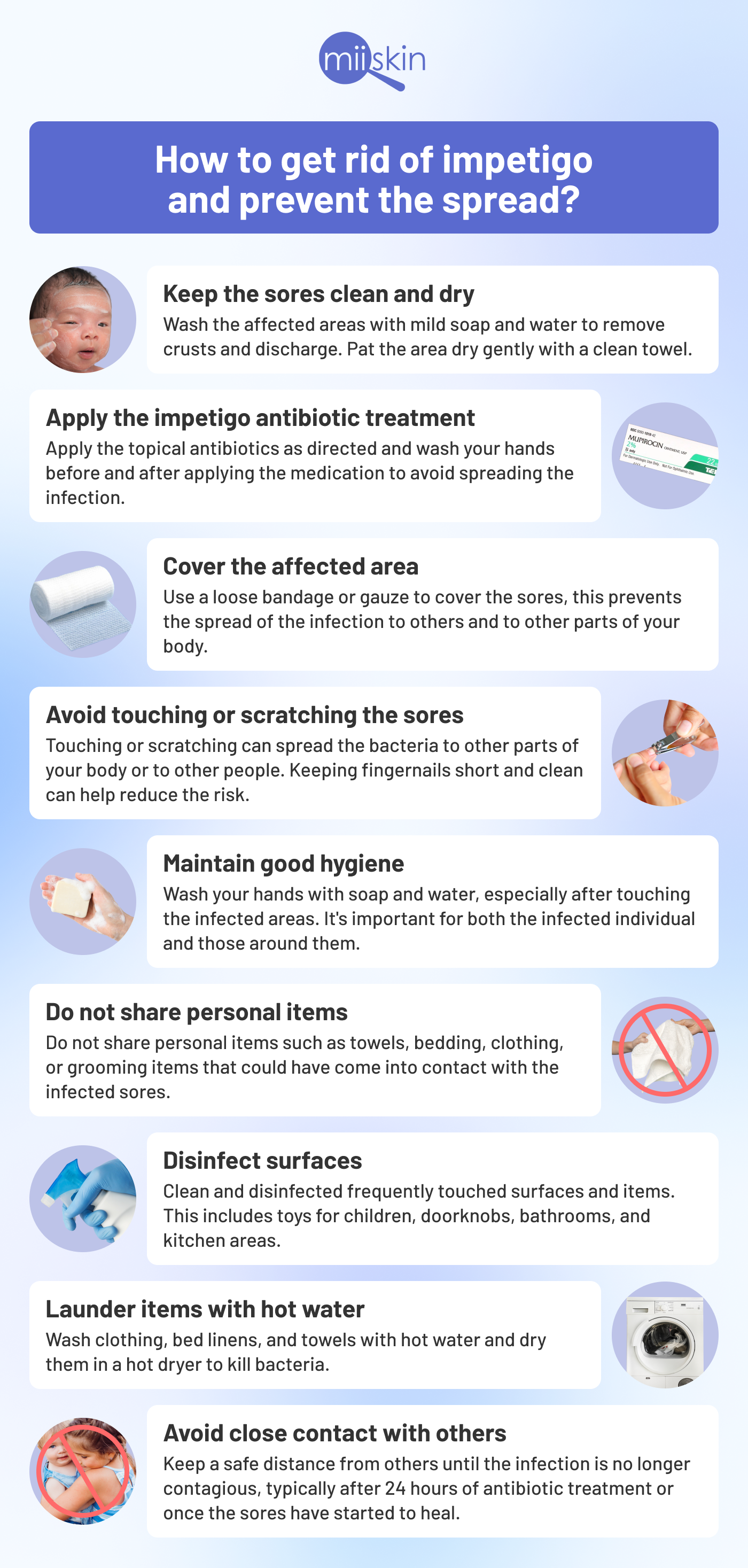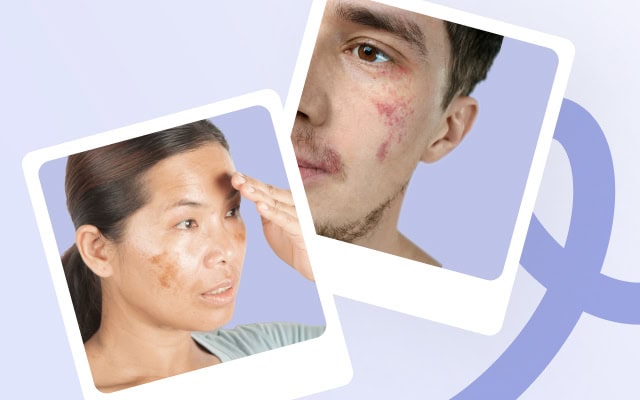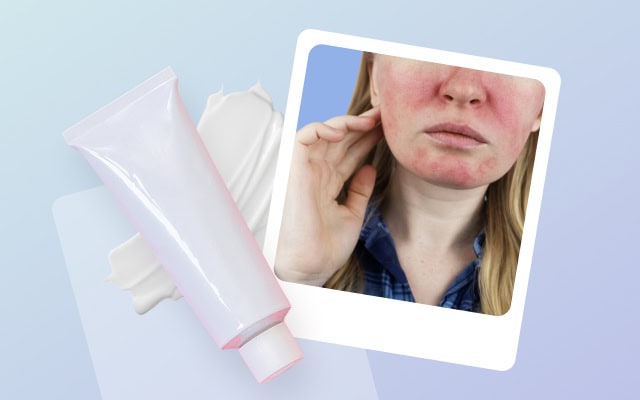What is the best treatment for impetigo?
Dr. Ben Williams, dermatologist, talks about the best impetigo treatment options and how to prevent the spread, and answers to frequently asked questions about this common bacterial infection.
Table of Content:
What is impetigo? | Can you get OTC treatment? | How to get a topical antibiotic? | What looks like impetigo? | How to get rid of it? | FAQ
Our commitment to producing high-quality content:
The information presented in this article is based on scientific research and the professional advice of our Content Medical Reviewers, who are experts in the field of Dermatology. How we write our content →
What is impetigo?
Impetigo is a common and highly contagious bacterial skin infection that usually affects infants and children. Impetigo typically manifests as red sores on the face, especially around a child’s nose and mouth, and on the hands and feet. These sores quickly rupture and ooze for a few days, then form a yellowish-brown crust. Impetigo treatment usually involves topical or oral antibiotics.
Impetigo represents about 10% of skin-related complaints among children. This infection predominantly affects children between 2 to 5 years old, though it can appear at any age. The highest rates of impetigo occur during the summer and fall months. Bullous impetigo is particularly common in infants, with children under two years old comprising 90% of bullous impetigo cases1.
Can I get impetigo treatment that is over-the-counter (OTC)?
Dr. Williams says there isn’t an effective over-the-counter (OTC) treatment for impetigo.
Impetigo is a bacterial skin infection that usually requires prescription antibiotics, either a topical one like mupirocin or retapamulin, or an oral antibiotic if it’s more widespread. OTC antibiotic ointments (like bacitracin or triple-antibiotic creams) are generally not strong enough to treat impetigo effectively and may allow the infection to worsen or spread.
If you suspect impetigo, especially if you have honey-colored crusts, spreading sores, or it’s near the nose or mouth—see a doctor promptly to start the right treatment and reduce the risk of complications or spreading it to others.
How to get treatment for impetigo?
Dr. Williams says that you can have an online consultation with a board-certified dermatologist via Miiskin. The doctor will examine the high-resolution photos of the sores on your face (or body) and your questionnaire. You will then get a prescription after 1-2 days that you can buy at the local pharmacy.
Secure, confidential, and reviewed by board-certified dermatologists.
Impetigo treatment: When to use creams or oral medication?
Dr. Williams says that the best impetigo medication includes oral or topical antibiotics, depending on the severity and extent of the infection.
Topical antibiotics
For mild cases, impetigo treatment creams are often sufficient. Mupirocin and fusidic acid are common choices, applied directly to the sores after gently washing and drying the affected areas2.
Oral antibiotics
In cases where impetigo is more widespread or if the topical treatment is ineffective, oral antibiotics may be prescribed. Commonly used oral antibiotics include penicillin derivatives like amoxicillin/clavulanate or cephalosporins, and in cases of allergy, macrolides like azithromycin might be used3.
What looks like impetigo?
Dr. Williams says there are several skin conditions that can resemble impetigo, making it important for a dermatologist to make an accurate diagnosis to get the right treatment. Some of these conditions include:
- Herpes simplex (cold sores) – Herpes causes fluid-filled blisters that can burst and crust over, much like the sores seen in impetigo.
- Eczema (atopic dermatitis) – This chronic skin condition can cause red, itchy areas that might get infected and crusted over, similar to impetigo.
- Contact dermatitis – This is an allergic reaction that can cause a red, itchy rash that might become blistered and crusted in severe cases.
- Folliculitis – An infection of the hair follicles that causes red, pus-filled bumps that can be mistaken for impetigo.
- Scabies – This infestation by mites can cause intense itching and a pimple-like rash, which can become infected and resemble impetigo.
- Varicella (Chickenpox) – This virus is characterized by itchy, fluid-filled blisters that burst and then form crusts, chickenpox can sometimes be confused with impetigo, especially in the early stages4.
How to get rid of impetigo and prevent the spread?
Caring for impetigo rashes (sores) properly can help speed up recovery, prevent the spread of the infection, and reduce the risk of complications.

Secure, confidential, and reviewed by board-certified dermatologists.
Frequently asked questions about impetigo and impetigo treatment
What causes impetigo?
Impetigo occurs when the skin becomes infected with bacteria, usually either Staphylococcus aureus or Streptococcus pyogenes5.
How do you get impetigo?
You can get impetigo through direct contact with the sores of an infected person or through contact with items that have touched infected skin, such as towels, bedding, clothing, or even toys. The bacteria that cause impetigo, typically Staphylococcus aureus or Streptococcus pyogenes, can enter the skin through minor cuts, abrasions, insect bites, or other breaks in the skin barrier.
What is the fastest way to cure impetigo?
Dr. Williams says that antibiotic creams are often used in order to make the symptoms go away faster and stop the infection from spreading. Antibiotic oral medications may be used if the impetigo has spread over larger areas of skin or as deemed fit by medical professionals. All antibiotic medications have to be prescribed by a doctor.
What is the best ointment for impetigo?
Dr. Williams says that impetigo is treated with prescription mupirocin antibiotic ointment or cream applied directly to the sores two to three times a day for five to 10 days.
Can Neosporin help impetigo?
According to Dr. Williams, Neosporin is generally of no benefit and in fact can make things much worse by causing an allergic contact dermatitis due to the highly allergenic antibiotic ingredients within it. However, for impetigo, prescription antibiotic treatments are usually recommended. These treatments often include stronger topical antibiotics like mupirocin or retapamulin, or oral antibiotics if the infection is extensive or has spread to multiple areas.
Are there different types of impetigo?
Dr. Wiliams says that impetigo primarily manifests in two types: non-bullous impetigo and bullous impetigo. This comparative table outlines the key differences between them.
| Feature | Non-bullous impetigo | Bullous impetigo |
| Cause | Mostly caused by Staphylococcus aureus or Streptococcus pyogenes. | Primarily caused by a type of Staphylococcus aureus that produces a toxin leading to blister formation. |
| Appearance | Starts as small red sores that quickly rupture to form yellowish-brown crusts. | Large, fluid-filled blisters that appear clear and then become cloudy. They are less likely to burst early. |
| Common sites | Often appears around the nose and mouth, and can also affect the limbs and torso. | Typically found on the trunk, buttocks, and extremities. |
| Symptoms | Red sores that burst and form a honey-colored crust, mild itching. | Larger blisters that may cause discomfort but are usually not painful, mild fever may occur. |
| Contagiousness | Highly contagious, spreads easily through direct contact with sores or via contaminated items. | Also contagious, though the intact blisters are less likely to spread bacteria until they burst. |
| Age Group Affected | Common in children aged 2-5 years but can affect all ages. | More common in infants and young children, though can affect adults as well. |
| Treatment | Topical antibiotics for localized infections; oral antibiotics for more widespread cases. | Typically requires oral antibiotics due to the risk of deeper skin infection and more widespread distribution6 7 |
Both types of impetigo require medical attention to manage effectively and prevent spreading, especially in environments such as schools or daycares.
Secure, confidential, and reviewed by board-certified dermatologists.
Can a child with impetigo go to school?
Dr. Williams says that since impetigo is highly contagious, affected children should not return to school or daycare until they are no longer contagious. This usually means waiting until the child has been on antibiotic treatment for at least 24 hours, the sores have begun to heal or can be reliably covered with dressings. Some schools may require a doctor’s note to confirm that a child is no longer contagious before returning to school.
Does impetigo affect adults?
Dr. Williams, dermatologist, says that although impetigo is more common in children it can also affect adults although it often occurs when the bacteria enters the skin through a minor cut, insect bite, or another type of skin injury. The infection presents similarly in adults as in children, with red sores that quickly rupture to form a crust, and it can be managed with similar treatments, including topical antibiotics or oral antibiotics depending on the severity8.
Can an adult with impetigo go to work?
An adult with impetigo should generally avoid going to work until they are no longer contagious, especially if their job involves close physical contact with others or if they work in sensitive environments like healthcare facilities, schools, or childcare centers.
Does poor hygiene cause impetigo?
Impetigo is a highly-contagious bacterial infection and poor hygiene can contribute to the spread of it, as it is acquired through close physical contact or by sharing items like towels, clothing, or toys that have come into contact with infected skin.
How long is impetigo contagious?
Dr. Williams says that impetigo is contagious until the sores start to heal or after 24 to 48 hours of effective antibiotic treatment. Without antibiotics, it can take several weeks for impetigo to stop being contagious, as the condition remains infectious until the sores fully crust over and heal. To prevent spreading impetigo, it is essential to follow prescribed treatment plans, keep the infected areas clean and covered, practice good hygiene, and avoid close contact with others until the risk of transmission is significantly reduced9.
Key points of the article
Description and contagion: Impetigo is a highly contagious bacterial skin infection that primarily affects babies and children. It presents as red sores on the face, hands, and feet, which break open and form yellow-brown crusts.
Prevalence and seasonality: It represents 10% of skin complaints in children, predominantly affecting those between 2 and 5 years old. The highest rates of impetigo occur in the summer and autumn, with bullous impetigo being more common in babies under two years old.
Diagnosis: Impetigo can closely resemble oral herpes and is generally diagnosed by a dermatologist through the observation of high-resolution photos of the sores. Laboratory tests are usually not required.
Treatment: Treatment includes topical antibiotics for mild cases and oral antibiotics for more severe or widespread infections.
Prevention and care: Keeping the sores clean and dry, applying antibiotic treatment, covering the affected areas, avoiding scratching, maintaining good hygiene, not sharing personal items, disinfecting surfaces, and avoiding close contact with others until the infection is no longer contagious are key measures to prevent the spread of impetigo.
Do you think you have impetigo?
Lee éste artículo en Español ¿Qué es el impétigo y cuál es el mejor tratamiento?
Article References:
https://www.ncbi.nlm.nih.gov/books/NBK430974/
https://www.cdc.gov/groupastrep/diseases-public/impetigo.html#
https://www.aafp.org/pubs/afp/issues/2007/0315/p859.html
https://www.ncbi.nlm.nih.gov/books/NBK279536/
https://www.cdc.gov/groupastrep/diseases-public/impetigo.html#
Skin conditions and treatments
Articles reviewed by dermatologists
Facial treatment for seborrheic dermatitis
How to get rid of rosacea permanently?
How to calm a rosacea flare-up fast?
Spongiotic dermatitis: What is it and what is the best treatment?
A dermatologist’s guide to psoriasis medication





 Still dealing with skin issues? Get expert help from home.
Still dealing with skin issues? Get expert help from home.
